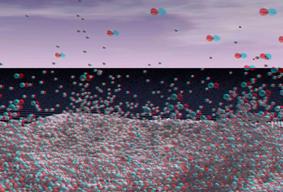Gallery
Home > Gallery
2021A Simulation of Water Strider Swimming on Water Surface using AMR methodA computer simulation of a water strider swimming on water surface is conducted by using a weakly compressible gas-liquid two-phase flow computational method. AMR (Adaptive Mesh Refinement) method works efficiently and the propulsion comes from the capillary force for the surface deformation driven by the middle leg. |
|
2020Violently Flattering FlagIt is familiar for us to see violently flattering flags with strong winds. It is a typical fluid-structure interaction problem. A wind deforms the flag and the deformation changes the wind. We compute violent flag deformations and interaction with turbulent flows by using the cumulant Lattice Boltzmann Method with AMR (Adaptive Mesh Refinement) method. Strong vortices are released continuously from the trailing edge. |
|
2020A Free-surface Flow including a lot of driftwoodsBy using Lattice Boltzmann Method based on the cumulant collision model, free-surface flows including a lot of driftwoods have been studied. The phase field equation describes the surfaces and the velocity extension method with level-set function extrapolates the distribution function into the air region. An octree-based AMR (Adaptive Mesh Refinement) method has assigned high-resolution mesh near the free surfaces and driftwoods. A space-filling based dynamic domain partitioning is used for large-scale computations with multiple GPUs.
|
|
2019Soap Bubble GrowingThe process of a soap bubble growing is simulated by using a weakly compressible computational method. An air is blowing into a soap bubble of 20 % glycerin aqueous solution. When the diameter has grown up to 12.5cm, the liquid film has 117mm thickness. An AMR (Adaptive Mesh Refinement) method greatly improves the computational efficiency with assignment of high-resolution mesh around the gas-liquid interface. |
|
2019Breaking-up of A Liquid JetA simulation of liquid jet injected into a compressed air has been carried out with a weakly compressible flow computational method. The jet is broken up and atomized in the air. A block AMR (Adaptive Mesh Refinement) method reduces the total mesh number to 1/30 uniform mesh and it takes 11 hours to complete the computation on a single NVIDIA Tesla V100 GPU.
|
|
2019Dolphin Free SwimmingA dolphin shape has been carefully scanned and a free-swimming by deforming the fail fin with a travelling wave has been studied by using a cumulant-collision LBM (Lattice Boltzmann Method) and AMR (Adaptive Mesh Refinement) technique with a octree data algorithm. A dynamic domain decomposition based on a space-filling curve has been also implemented to use multiple GPU nodes. The computation is carried out on TSUBAME3.0.
|
|
2018Forming Liquid Film on a SpoonIt often appears that a liquid film is formed by pouring a water on a spoon. Two novel methods of a weakly compressible computation and octree-based block AMR (Adaptive Mesh Refinement) make it possible to compute the two-phase flow forming a liquid film with hydrodynamic stabilization.
|
|
2011Two-phase Flow Simulation of Oil-Air Steering with a Rotating GearA oil-air two-phase flow is solved by mesh-based semi-implicit numerical method on a rotating frame.
|
|
2011Large-scale GPU Simulation for Dendritic Solidification of Al-Si Alloy3-dimensional Phase-Field Simulation for the dendritic solidification of Al-Si binary alloy. A performance of 2.0 PFLOPS has been achieved on 4,000 GPU of the TSUBAME 2.0 supercomputer
|
|
2010A Typhoon Simulation on Horizontal 500-m Mesh using the Next-Generation Weather Prediction Model ASUCAThe next-generation weather prediction model ASUCA being developed by Japan Meteorological Agency has been implemented on a GPU rich supercomputer TSUBAME2.0. A typhoon simulation is successfully carried out with horizontal 500m mesh covering the whole Japan area. |
|
2010A Gas-Liquid Two-Phase Flow Simulation using Multi-GPU computingA leading water of the breaking dam water launching into a wet floor becomes strongly violent, which is quit different from that into a dry floor. A two-phase flow model is solved on a numerical mesh and a multi-GPU sparse matrix solver using Krylov subspace iteration method with a MG preconditioner has been developed for the pressure Poisson equation.
|
|
2009GPU Computing for Dendritic Solidification of a Pure Metal based on Phase-Field ModelA large-scale GPU simulation for a dendritic solidification of a pure metal is carried out using 60 GPUs of NVIDIA Tesla S1070 on TSUBAME1.2 and a performance of 60 TFlops has been achieved for the computation of 1024x1024x1024 mesh.
|
|
2008GPU Computing for Rayleigh-Taylor instabilityCompressible CFD application can be accelerated on GPU. The Euler equation is accurately solved by conservative IDO scheme. When GeForce GTX280 is used, 40 times speed-up (54 GFlops) is achieved.
|
|
2008Tsunami Simulation on GPUThe shallow water equation is solved by the conservative IDO scheme. The tsunami run-up to dry area can be computed accurately. The GPU computing achieves 60 times speed-up for NVIDIA GeForce GTX280.
|
|
2008Granular Behavior composed of non-spherical particle shapes.Such non-spherical shapes as rice are taken into consideration to study numerically the real granular phenomena, and the numerical results are in good agreement with the experiment.
|
|
2007Rock Falling SimulationThe complex shapes of rocks are modeled as assemblies of small particles rigidly connecting each others. In order to describe the rotation of rocks, quaternion is introduced. |
|
2006Meso-scale Atmosphere Model (Typhoon Simulation)Non-hydrostatic atmosphere model is necessary to study typhoon. In collaboration with HyRAC Nagoya University, spiral rain bands are described well.
|
|
2005Rising Bubbly FlowThe Multiphase flow is solved by the CIP method. The bubbly flow collaboration with JAEA. The photo-realistic images are visualized by the ray-tracing technique of the software POV-Ray.
|
|
2003Explosion-BlastwaveExtremely high pressure of the detonation product gas drives hydrodynamic instabilities for the blastwave evolved into turbulent state. |
|
20023D Visualization for Particle Simulation (DEM)Granular phenomena like Meteorite Impact on the ground. The simulation is based on the Distinct Element Method and parallelized by OpenMP. To see the 3D graphics, an anaglyph glass is |
 |
2001Falling LeavesFluid-Structure Interaction study using overset grid method and IDO scheme. The falling trajectory of the leaves strongly depend on the initial attitudes.
|
|